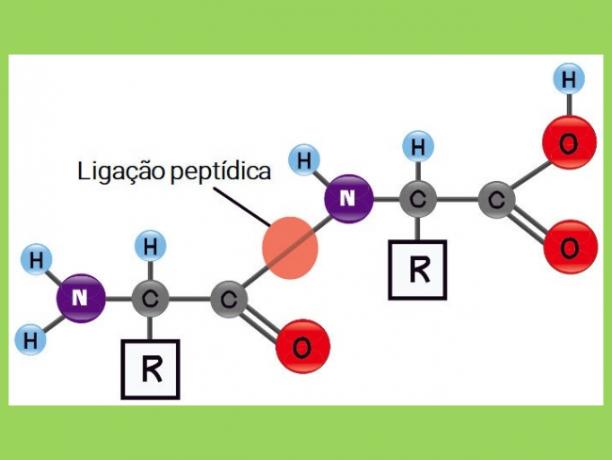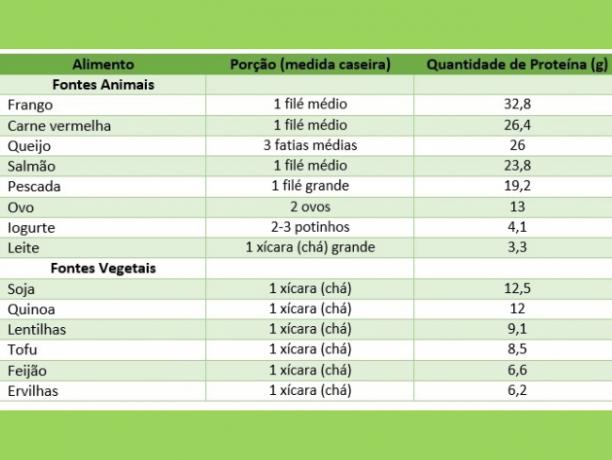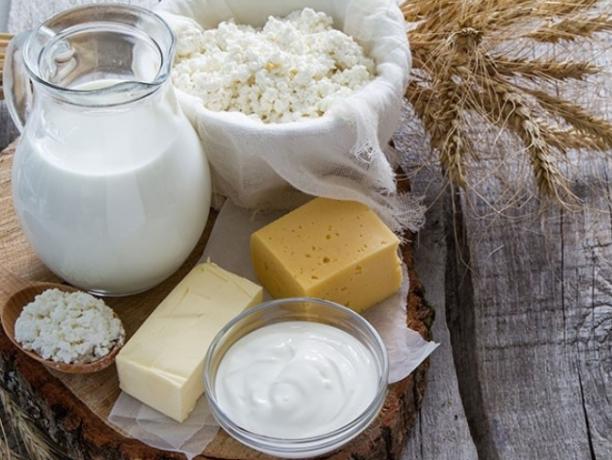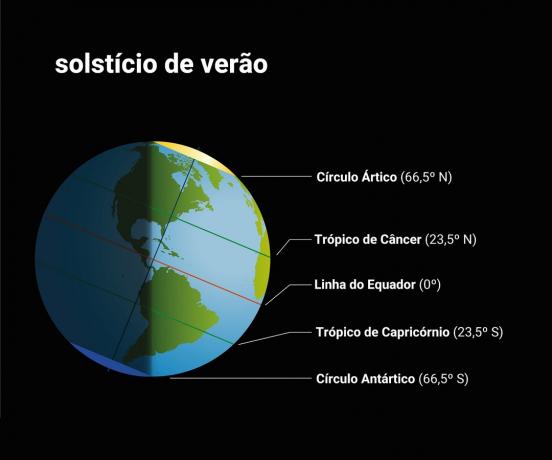Proteins are essential nutrients for the human body, consisting of biological macromolecules formed by one or more chains of amino acids.
More than half of the dry weight of cells in all living beings is made up of proteins, the most important biological macromolecules.
These macromolecules are abundantly found in foods of animal origin.
Protein composition
The composition and other characteristics of proteins are the object of study in biochemistry, which is a subdiscipline of biology.
The composition of proteins has carbon, hydrogen, nitrogen and oxygen and in practically all of them there is also the presence of sulfur. Elements like iron, zinc and copper may also be present.
Proteins are basically composed of a set of amino acids that are covalently linked together.
A long chain of amino acids is a polypeptide.
These bonds between amino acids are called peptide bonds.
Peptide bonds occur as a reaction between the group the mine (organic compound derived from ammonia) of an amino acid and the group carboxyl (carboxylic acids component) from others.

C = Carbon; H=Hydrogen; O=Oxygen; N=Nitrogen; R= Group R or Side Chain (amino acid identity).
There are 20 amino acids that can combine in different ways to form different types of proteins.
know more about amino acids.
Types of proteins
Proteins can be classified into two groups according to their function in the body: dynamic proteins and structural proteins.
dynamic proteins
Dynamic proteins have the function of defending the body, transporting substances, catalyzing reactions and controlling metabolism.
structural proteins
Structural proteins have the main function of forming the structure of cells and tissues in the body.
Protein classification
The classification of proteins varies according to the main factor taken into account.
Composition classification
When the object of study is the composition of proteins, they can be classified into two groups:
- simple proteins: are those that only release amino acids during hydrolysis.
- conjugated proteins: proteins that, during hydrolysis, release amino acids and a non-peptide radical.
Ranking by number of polypeptide chains
Regarding the number of polypeptide chains, proteins can be classified as:
- monomeric proteins: are proteins that only have one polypeptide chain.
- oligomeric proteins: are proteins formed by more than one polypeptide chain.
Classification by form
With regard to shape, proteins can be classified into two types:
- Fibrous proteins: In fibrous proteins, the polypeptide chains curl up like a rope. One of the characteristics of fibrous proteins is that they are not soluble in aqueous solutions. Furthermore, they are responsible for the strength and flexibility of the structures where they are present. Examples of fibrous proteins: keratin, collagen
- Globular proteins: the polypeptide chains of globular proteins fold into shape approximately spherical or as the name implies, globular, making them resemble a globe. Globular proteins are usually soluble in aqueous solutions. Examples of globular proteins: hemoglobin, enzymes.

Images of a fibrous protein and a globular protein
know more about hemoglobin and enzyme.
protein structure
Regarding the structure of the protein molecule, see how it can be classified:

primary structure
The primary structure is genetically determined. It is the simplest structure of all, where the amino acids are arranged in a linear fashion.
secondary structure
For a protein structure to be secondary, the primary structure must have amino acids covalently linked together. Therefore, molecules can undergo rotations and ultimately self-interact in three ways:
- alpha helix: takes on helical shape when hydrogen bonds between amino acids occur.
- beta sheets: when there are hydrogen bonds between amino acids and the consequent generation of a sheet and rigid structure.
- Ties: they are non-regular structures in the nucleus and their formation takes place outside the protein folding.
tertiary structure
It occurs when the unfolding of the secondary structure is arranged in space in a three-dimensional way.
quaternary structure
This structure takes place through an interaction between identical or not identical polypeptide chains, which group together and form a single three-dimensional structure.
Protein Functions
Proteins play a fundamental role in the body. They are the basis for the material that forms organs and tissues, as well as the basis for the formation of bones, hair, teeth, etc.
The protein's function varies according to its shape and structure. Virtually all cell functions must be mediated by proteins.
Check out some of the main functions of proteins below.
- Structure the cells.
- Act as enzymes and thereby accelerate chemical reactions.
- Transporting molecules and ions.
- Store substances.
- Assist the movement of cells and tissues.
- Build and repair tissue and muscle.
- Participate in gene regulation.
- Cause muscle contraction through the action of two types of protein: myosin and actin.
- Defend the body (antibodies are types of proteins).
- Carrying Oxygen (Hemoglobin is the protein that carries oxygen throughout the body).
- Provide energy.
- Acting in the regulation of metabolism in the form of hormones.
Protein characteristics
One of the main characteristics of proteins is an ability called denaturation. Denaturation is the irreversible change in the properties of proteins when they are heated or stirred.
As far as the human body is concerned, it is the second largest component of the organism, second only to water.
The characteristics of proteins differ according to their origin: those of animal origin have a higher biological value; they are considered complete proteins, with all essential amino acids in optimal amounts and proportions.
Proteins and food
When we eat a food, the use of proteins by our body takes place through digestion.
In digestion, proteins are exposed to an acid and to hydrolysis and so happens your denaturation.
When subjected to excessive heat and agitation, for example, secondary and tertiary structures undergo irreversible changes and, as a result, lose their properties. For this reason, certain foods lose their nutritional power when cooked.
Proteins can be of animal and plant origin.
Know the main characteristics of these proteins.
| animal proteins | vegetable proteins |
|---|---|
| They have a high biological value. They are complete proteins, with all the essential amino acids in ideal amounts and proportions. | They have a low biological value, that is, the amount of essential amino acids is lower. |
| They have a greater amount of nitrogen compared to vegetable proteins. | Compared to animal proteins, they have a greater amount of the amino acid arginine, which makes the immune system more effective. |
| They are rich in calcium, iron, vitamin B12 and zinc. | They are rich in carbohydrates and vitamins. |
| They have a lot of harmful fat. | They do not contain harmful fat. |
| They have few fibers. | They are rich in fiber. |
Foods rich in animal protein
Below is a list of examples of protein foods of animal origin.
- Tuna fish
- Shrimp
- Red meat
- Chicken
- Eggs
- Peru
- Pig
- Yogurt
Foods rich in vegetable protein
Below is a list of examples of protein foods of plant origin.
- Almond
- Peanut
- Brown rice
- Oat
- Broccoli
- Pea
- Spinach
- baked beans
- lentils
Among plant foods, there are also some high protein fruits:
- Avocado
- Prune
- Banana
- dry apricot
- Fig
- Raspberry
- Guava
- Jabuticaba
- jackfruit
- Orange
- Melon
- Pass grape

protein digestion
The protein digestion process starts in the stomach. The hydrochloric acid present in it starts the process by denaturing the proteins, that is, destroying the hydrogen bonds in their structure.
After that, the proteolytic chains lose their shape and are subjected to the action of enzymes. At this point, the pepsin enzyme causes the proteins to become smaller molecules, ie, the pepsin causes a partial degradation of the protein and hydrolyzes the peptide bonds.
The second stage of protein digestion takes place in the small intestine. In it, proteins are subjected to the actions of pancreatic enzymes. After that, the peptides and amino acids are absorbed and taken to the liver.

Enzymes that participate in protein digestion
The percentage of protein released by the body in the form of faeces corresponds to about 1% of the amount ingested.
protein synthesis
Protein synthesis is a process determined by DNA, in which biological cells generate new proteins. This occurs in every cell in the body.
During the process, there is a transcription of the DNA by the messenger RNA and then a translation of this information by the ribosomes and the transporter RNA, which carries the amino acids.
The amino acid sequence determines protein formation.
Protein synthesis is divided into three phases: transcription, Translation and amino acid activation.
know more about RNA and DNA.
Transcription
In the transcription phase, messenger RNA (mRNA) transcribes the message from the cistron (part of the DNA).
The RNA polymerase enzyme binds to an enzyme complex. The double helix is undone and with it the hydrogen bonds that link the bases of the chains are destroyed.
After that, the process of synthesizing an mRNA molecule begins. During this process, the connections between the bases occur:
- DNA adenine with mRNA uracil.
- DNA thymine with mRNA adenine.
- cytosine from DNA with guanine from mRNA and so on.
Eventually, the mRNA molecule separates from the DNA strand (which in turn has hydrogen bonds again) and the double helix is re-established.
Before leaving the nucleus, the RNA is matured or processed. Some of its parts are removed and the ones that remain form bonds with each other and form a mature RNA.
This RNA has the coding of amino acids and can pass to the cytoplasm, which is the part of the cell where the translation phase will take place.
Translation
It is at this stage that proteins are formed.
The translation phase takes place in the cell's cytoplasm and consists of a process where the message present in the mRNA is decoded in the ribosome.
Activation of amino acids
During the translation process, the Transport RNA (tRNA) comes into play. It is so designated because it has the function of transporting amino acids from the cytoplasm to the ribosomes.
The amino acids are then activated by certain enzymes that bind to the tRNA, giving rise to the aa-tRNA complex.
Protein electrophoresis
Protein electrophoresis is a test that consists of separating the proteins found in urine (urinary proteins) or in blood serum (serum proteins).
It is a test used to detect the absence, reduction or increase of proteins, in addition to detecting the presence of abnormal proteins. This test aids in the diagnosis of diseases that affect protein absorption, loss and production.
An irregular amount of proteins can indicate, for example, kidney problems, diabetes, autoimmune diseases and cancer.
Measuring the amount of total protein can also indicate an individual's nutritional status.
Excess protein in the body
Protein intake should be moderate, as too much of it can result in health problems. An organism that has an excessive amount of protein can suffer kidney damage (for example, stones) and develop diseases such as arteriosclerosis and osteoporosis, have weight gain and problems with liver.
For this reason, it is necessary to be very careful when following the so-called “protein diet” (diet based on foods that are good sources of protein), as consumption cannot be exaggerated.
Low protein in the body
While an excessive amount of protein in the body is harmful to the body, a too low amount is also harmful.
One of the effects caused by the low amount of protein in the body is, for example, atrophy of a part of the central nervous system.
In addition, the individual may also experience weight loss, constant tiredness, muscle pain, healing problems, hair loss, etc.
Curiosities
Muscle proteins
The consumption of protein-rich foods is of fundamental importance for those who exercise with the intention of gaining muscle mass.

During weight training, protein breakdown occurs in muscle tissue. In order for the repair of these tissues to take place, the organism looks for the existing proteins in the diet.
For this reason, it is essential that an individual who exercises and wants to achieve certain muscle growth eats protein-rich foods on a regular basis throughout the day.
Some people resort to using protein supplements to supplement their recommended daily intake.

However, this use must be accompanied by a specialist in nutrition, who will have tells the person's eating habits, their lifestyle and the sport practiced, among others.
Allergy to cow's milk protein
Allergy to cow's milk protein, also known as APLV, is considered the most frequent food allergy. It is estimated that 2.2% of children present the APLV picture in the first years of life.
It is an allergic reaction that the organism has not only when in contact with cow's milk, but also when in contact with its derivatives.

See too what does vegan mean and what does a vegan eat.
This reaction can manifest itself in three different ways: IgE mediated, non-IgE mediated or mixed.
Check below some characteristics of each of the forms of manifestation:
| IgE mediated | Non-IgE mediated | mixed |
|---|---|---|
| O organism produces antibodies specific IgE (Immunoglubulins E) to fight milk proteins. | The allergic reaction is not triggered by the production of specific IgE antibodies, but by the inflammatory cell production. | The allergic reaction is triggered by both production of IgE-type antibodies, as well as by other cells in the body. |
| At reactions arise immediately, appearing even seconds after contact with milk or its derivatives. | At reactions can appear hours or days after contact with cow's milk or its derivatives. | At reactions can arise immediately after contact with cow's milk or its derivatives, or long after. |
| Main symptoms: vomiting, red plaques that make the body itchy, breathing difficulties, swollen eyes and lips, diarrhea and anaphylactic shock. | Main symptoms: vomiting, constipation, diarrhea (sometimes with mucus or blood), cramps and inflamed bowel. | Main symptoms: dry skin, with desquamation (eventually with wounds), diarrhea, vomiting, inflamed stomach and/or esophagus, abdominal pain and reflux. |


